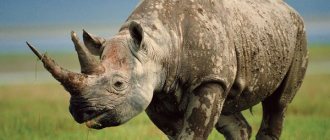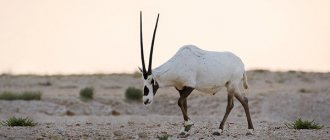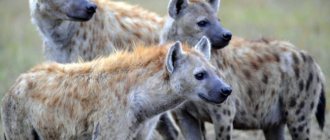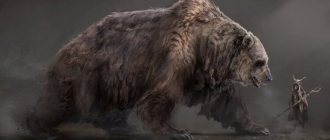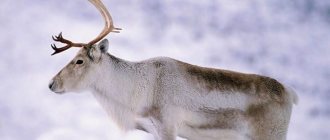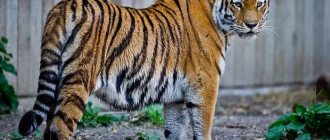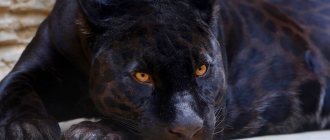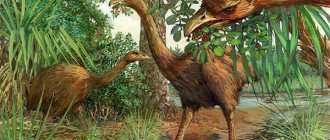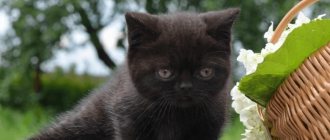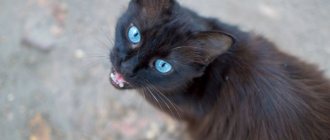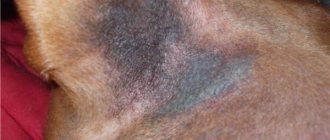Security status: In critical condition. Listed in the Red Book of the International Union for Conservation of Nature.
The black rhinoceros (Diceros bicornis) is one of two species of African rhinoceros. Despite the name, like the white rhinoceros, it can have different colors: from dark yellow to dark brown or dark gray. It is distinguished from white by the presence of a tenacious upper lip, which is adapted for feeding on the leaves of woody and herbaceous plants. Also, the black rhinoceros has a shorter head, the horn is directed forward, and the body is more elongated and less massive.
Black rhinoceroses have two horns, and in some cases a small third one may be present. The anterior horn is larger than the posterior one; on average, its length is 50 centimeters. The size of the black rhinoceros varies between 800-2000 kilograms, but sometimes you can find individuals over 2 tons. Black rhinoceroses live in transitional forest grassland zones, but are also found in the deserts of southwest Africa and the forests of Kenya. This species, as a rule, chooses a habitat within a 25-kilometer zone of accessibility to water sources. Black rhinos love to pamper themselves by spending a lot of time in the water or taking mud baths. This is how these animals cool down.
Adults prefer a solitary lifestyle, although they can form groups of up to 12 representatives. Mothers and daughters tend to stay together for long periods of time, and females without offspring may unite. Conflict situations arise when outsiders enter territory occupied by another clan, and during the mating season, the fight for females can even lead to the death of one of the competing males. Despite the fact that females reach sexual maturity at the age of 4-5 years, they cannot have offspring until 6.5-7 years. Males have to wait up to 10-12 years to claim territory and females. Black rhinoceros breeding can occur throughout the year. The gestation period lasts 419-478 days. The time interval between the birth of offspring in one female is 2.5-3.5 years. The lifespan of a black rhinoceros is 40-50 years.
The black rhinoceros's diet consists of tree branches, legumes and various types of plants, but the most favorite delicacy is acacia. Feeding usually occurs early in the morning or evening, as rhinoceroses rest during the day. If water is nearby, these animals will drink it daily. They also regularly lick useful minerals.
Rhinoceroses and people
Previously, large herds of black rhinoceroses were almost completely destroyed due to the use of their horns in Eastern medicine as a powerful tonic. In the East, products made from its horn are also highly valued.
For example, in Yemen, social status among many tribes is determined by the possession of a dagger made from it. In our realities, this is akin to having a diploma of higher education, so local ambitious residents spare no expense to acquire an item that is so necessary in public life. The animal was called a black rhinoceros due to a misunderstanding, like its larger white counterpart.
In both species, the skin is never white or black, but rather gray in various shades. Dutch settlers at the beginning of the 19th century named the white rhinoceros wijd, which means “wide”.
English armchair scientists who did not know the Afrikaans language decided that wijd was equivalent to the English white - “white”. So, first, in the silence of the office, a white rhinoceros was born, and at the end of the 19th century, an unknown egg-headed thinker blessed zoology with the appearance of a black rhinoceros, in order to distinguish it from the larger white one. Over time, this nonsense came into scientific use in almost all modern languages.
In the past, black rhinoceroses lived across vast areas of the African continent south of the Sahara, with the exception of tropical forests in the Congo Basin. Now isolated populations have survived only in national parks and reserves.
The natural habitat of these animals is the bush - a borderland overgrown with thorny bushes of tropical rainforests and grassy savannas.
- 100 facts about bears
- Jungle animals
- Saber-toothed tiger
- 50 facts about kangaroos
- long eared hedgehog
- Cross spider
Appearance
The black rhinoceros is a fairly large mammal, whose weight can reach up to 3600 kilograms. The adult black rhinoceros is a powerful animal, up to 3.2 meters long and 150 centimeters high. The animal's face is most often decorated with 2 horns, but there are areas in Africa, especially in Zambia, where you can find rhinoceroses of this species with 3 or even 5 horns. The horn of a black rhinoceros is round in cross-section (for comparison, white rhinoceroses have a trapezoidal horn). The front horn of a rhinoceros is the largest, the horn reaches a length of up to 60 centimeters.
The color of a black rhinoceros mostly depends on the color of the soil where the animal lives. As you know, rhinoceroses love to wallow in dirt and dust. Then the rhinoceros’s original light gray skin color takes on a different shade, sometimes reddish, sometimes whitish. And in those areas where lava hardens, the skin of the rhinoceros takes on a black tint. Also, in appearance, a black rhinoceros differs from a white one in the appearance of its upper lip. The black rhinoceros has a pointed upper lip, which hangs over the lower lip in a distinctive proboscis. This makes it easier for the animal to use this lip to grab leaves from bushes and branches.
Subspecies
There are four main subspecies of the black rhinoceros:
- South-central black rhinoceros (D. bicornis minor): Historically, the range extended from central Tanzania through Zambia, Zimbabwe, Mozambique to northern and eastern South Africa. This subspecies is now found in South Africa and Zimbabwe, with smaller numbers found in southern Tanzania. The restored habitats are located in Botswana, Malawi, Swaziland and Zambia. The south-central black rhinoceros is by far the most numerous subspecies, but is still classified as critically endangered.
- Southwestern black rhinoceros (D. bicornis bicornis): This subspecies is most adapted to living in arid and semi-arid savannas. Their habitat included: Namibia, southern Angola, western Botswana, southeastern and southwestern South Africa. Now the subspecies is widespread in Namibia and South Africa. The population of the subspecies is in critical condition.
- East African black rhinoceros (D. bicornis michaeli): Historically, its distribution has been recorded in southern Sudan, Ethiopia, Somalia, Kenya and north-central Tanzania. Now you can find a smaller number of this subspecies in Kenya, and most of the subspecies is distributed in northern Tanzania. The subspecies is in critical condition.
- West African black rhinoceros (D. bicornis longipes): Was distributed in the savannas of most countries in western Africa. By the beginning of the century, the number of this subspecies was reduced to only a few individuals in the north of Cameroon. During a large study in 2006, not a single individual of this subspecies was found. The West African black rhinoceros has been officially declared extinct since 2011.
Lifestyle
Basically, black equids live in areas with dry landscapes, and they do not leave these areas even during periods of very severe droughts. These mammals are strongly attached to the territory where they settle, and, as a rule, do not leave it throughout their lives. But there are rhinoceroses that roam, looking for water and food. Black rhinoceroses are solitary animals, females and males live separately. The cubs live with the female for a long time, especially female offspring. When black rhinos go out for a walk, the female follows her offspring, while for white rhinos it’s the other way around. Sometimes you can find small clans, which include no more than twelve individuals. Females that do not have cubs form groups.
These animals feed on plants - all kinds of young shoots, legumes, branches and thorns. Eating such food, they do not notice its hardness, sharp thorns and their very caustic juice. Their favorite “dish” is acacia. Animals get food with the help of their upper lip, which is movable in its structure.
These animals go to water every day. To get to it they can walk about twelve kilometers. During periods of drought, rhinoceroses use the pits left behind by elephants. These animals eat twice a day and sleep for nine hours at night. And on a day when it is very hot, they bathe in the mud or rest under trees in the shade. When rhinoceroses rest, Egyptian herons, buffalo birds and water turtles remove various parasites and ticks from their skin.
These odd-toed ungulates have very poor eyesight, they can hardly see a tree or a person that is fifty meters away from them, for this reason, when meeting a rhinoceros, you need to freeze and not make any movements. But their hearing is good and their sense of smell is very well developed, thanks to this the animals are well oriented in the area. Despite their heavy weight, they can run very fast, reaching speeds of up to 48 kilometers per hour. They do not know how to overcome obstacles and swim. These wonderful animals are very sociable. You can often hear them snort, but when they are in pain or scared they make loud sounds that sound like a whistle.
Despite their sociability, the animals are very aggressive and can attack any object that moves. These horned animals are not afraid of other inhabitants of the shroud and even let them get close to them, but animals that get in the way of a rhinoceros can suffer greatly, since an angry rhinoceros is quite dangerous. Competition may sometimes arise between males for a female or for territory. But more often females and males fight. And, for example, they live in peace with antelopes, zebras and buffalos. When animals go to a watering hole and the rhinoceros does not want to give way to the elephant, a fight ensues and the elephant often wins. The main rival of the black rhinoceros is the elephant.
The avid enemies of equids are lions, Nile crocodiles and hyenas. But attacks on adult animals are extremely rare. This usually happens when the rhinoceros is lying in the mud, then it becomes an easy prey. Mostly enemies attack cubs. People are also enemies of these animals, as they often hunt them for trophies. The average lifespan of rhinoceroses is about forty years.
Reproduction
Rhino reproduction does not depend on the season. Females begin to mate and give birth to offspring when they reach seven years of age, but they reach sexual maturity at four years of age. Males are ready to reproduce at a young age, but this happens at 10-12 years of age. Rhinoceroses do not live in pairs and only come together to breed. The female's pregnancy lasts fifteen months. Basically, only one cub is born, which very quickly gets to its feet. The female feeds her offspring with milk. This may last up to two years. A female can produce offspring no more than once every four years.
Best articles: Drops Advocate for cats
Subspecies
There are four subspecies:
- South-central subspecies. Lives in South Africa, Tanzania and Zimbabwe. This subspecies is the most numerous.
- Southwestern subspecies. It can be found in South Africa and Namibia. Rhinoceroses of this species tend to live in arid and semi-arid areas. The number of the species is critical.
- East African subspecies. Individuals of this species live in Tanzania and Kenya. This subspecies is on the verge of extinction.
- West African subspecies. Since 2011, this subspecies is considered extinct, and before that it lived in Cameroon.
Currently, 98% of these animals live in South Africa, Zambia, Zimbabwe, Tanzania, Kenya and Namibia. Most of the animals live in national parks, where their habitat never changes.
https://youtube.com/watch?v=x9NaWGxA55c
Habitat
At the beginning of the 20th century, a huge population of black rhinoceroses was seen in Eastern and Southern Africa, with smaller numbers in Central South Africa. Unfortunately, very soon these animals were exterminated by poachers, so they suffered the same fate as many African animals - black rhinoceroses were resettled in national parks .
The black rhinoceros is a vegetarian animal. It lives mainly where the landscape is dry, be it acacia, shrub savannas, sparse forests or spacious, open steppes. The black rhinoceros can be found in the semi-desert, but very rarely. The animal does not like to penetrate into the tropical, humid forests of West Africa and the Congo Basin. And all because rhinoceroses do not know how to swim, even very small water obstacles are difficult for them to overcome.
The origins of the myths about the miraculous power of the horn
The origins of all beliefs and fables about rhinoceroses go back to mythology. The rhinoceros served as the prototype of the mythical unicorn, which can be found in myths and fairy tales. Even medieval scientists imagined rhinoceroses in the form of fairy-tale animals. The first realistic portrait of a rhinoceros was created in 1515 by the artist Albrecht Durer. Dürer relied on stories and descriptions given by travelers. Therefore, the rhinoceros in his image turned out to be covered with scales and a thick shell. According to Dürer, “the strength and spirit of the dragon” coexisted in the rhinoceros. Even when researchers became more familiar with the way of life, scientists had the skins of rhinoceroses at their disposal, and the most unimaginable legends continued to circulate about them.
Behavior
Representatives of this species lead a solitary lifestyle. Each animal has its own home area, leading to a watering hole. Around one watering hole a peculiar clan of rhinoceroses is formed, the members of which recognize each other by smell and do not show any aggression towards their relatives.
The clan has "communal pastures" of up to 80 square meters. km, where they periodically graze peacefully. The giants intensively mark the territory of their ancestral home range with their excrement and try to protect it from any encroachment.
The diet of equids includes about 200 different plant species.
They most readily eat euphorbia, aloe and wild watermelons. Leaves, young shoots and even thorny branches of acacia are also highly respected. The tenacious proboscis on the upper lip helps the mammal pluck leaves from the branches of a bush.
During the day, the rhinoceros eats green mass in a volume equal to almost 2% of its weight. Thick, rough skin allows you to ignore thorns in the densest thickets. The animal should go to water at least once a day.
A myriad of parasites live on his skin, so to destroy them he has to regularly take mud baths or simply roll in the dust. Buffalo starlings also help him fight annoying insects, which not only thoroughly cleanse his skin of parasites, but also raise an alarm cry at the slightest danger.
Black rhinoceroses often show increased aggressiveness towards other species of animals and representatives of other clans and attack anyone who has crossed the boundaries of their possessions, developing speeds of up to 50 km/h during the attack.
Nutrition
- Animals prefer to stick to vegetarianism. They eat about 70 kg per day. food of plant origin. The diet is based on grass. Animals tear it off with powerful and mobile lips, and also pick up fallen leaves. Some individuals are partial to shoots of bushes and trees. They can tear out an acacia tree with roots, absorbing it in huge volumes.
- The wedge-shaped lip is otherwise called the proboscis. She breaks off the branches. These mammals like elephant grass and also eat aquatic vegetation and reed shoots. Sugar cane is considered a favorite delicacy; bamboo, figs, and mangoes are consumed.
- As for food in captivity, when these representatives of the family are kept in a zoo, they are provided with hay and are also treated to fresh grass. Vitamin complexes must be added. Leaves and shoots are added to the food.
- Giants can feed regardless of the time of day. Individuals of the black species primarily feed in the morning and evening. As for the rest of the rhinoceroses, they can remain active both at night and during the day.
- A huge animal can consume from 50 to 170 liters per day. water. Such indicators are highly dependent on the weather. During drought, individuals are able to go without water for 4-5 days.
This is interesting: White hare - description, habitat, what they eat and how they reproduce
Reproduction
At the beginning of the mating season, females emit a special smell that attracts nearby males. If several males come to a female, then ritual fights are sure to take place between them.
Before entering into battle, rivals snort menacingly and try to scare the opponent. Weaker males in most cases wisely leave the battlefield. The most formidable male stays for several days with the female, spending time eating grass together and grunting gently.
To make a pleasant and lasting impression on his chosen one, the gallant gentleman often empties the contents of the gastrointestinal tract and selflessly throws it in different directions. Having had enough fun, the partners separate and continue to live separately.
Pregnancy lasts about 400 days, after which a hornless baby weighing up to 40 kg is born in secluded thickets.
He quickly gets to his feet and soon begins to walk independently. The first days he hides with his mother from prying eyes. At this time, the female is very irritable and attacks everything that moves nearby.
Until the age of 2 years, the baby feeds on mother's milk. By this age, he grows to such a size that he is forced to lie down on the ground in order to reach the desired nipples. From the age of three, he begins to grow horns, but he continues to remain with his mother until her next cub appears. Females become sexually mature at 4 years, and males at 6-7 years.
Population size and distribution of the species in our time
Current habitat of the black rhinoceros Thanks to successful conservation efforts and anti-poaching efforts, the total number of black rhinoceros has increased to 4,838 individuals. This species currently has an uneven distribution from Cameroon west to Kenya and east to southern South Africa. However, almost 98% of the total number of black rhinoceros live in just 4 countries: South Africa, Namibia, Zimbabwe, Kenya. Of these countries, the Republic of South Africa is home to approximately 40% of the total number of black rhinoceros living in the wild.
Baraka - the blind dragon
We don’t believe in rhinoceros dragons, so in the reserve we had the pleasure of talking with the small blind black rhinoceros Baraka. The animal cannot see at all. Although rhinoceroses themselves have poor eyesight by nature, this one is one hundred percent blind from birth, and therefore needs human protection, otherwise even hyenas can devour it if they attack in a pack. Of course, he can recognize danger by smell, but it’s not so easy to run blind from enemies through the forest or savannah... And it’s difficult to get food without seeing anything around.
That day we saw several more rhinoceroses, and then a whole herd of these “dragons,” but the one, blind with sawed-off horns, standing very close to us, outshone all the others. The meeting was touching - so many years have passed since our last meeting - and sad at the same time. Baraka is lonely and bored. Although his territory is quite large and there are many trees around, he is well oriented, spending most of his time near the wire fence, to which visitors approach, accompanied by rangers.
History of population size and distribution
Historical range of the black rhinoceros Black rhinoceroses were once distributed throughout sub-Saharan Africa, with the exception of the Congo River basin. Even the fact that these animals are solitary was not noticed due to the large number. During the day they could be found in flocks numbering dozens of individuals. The estimated number of black rhinoceros on the continent was around 70,000. However, uncontrolled hunting by European settlers catastrophically reduced the population and habitats of the black rhinoceros.
By the end of the 1960s, these animals had disappeared from many countries or were on the verge of extinction. An epidemic of poaching in the early 1970s wiped out most black rhinoceroses living in the wild, and also significantly reduced the number of these animals in national parks and reserves. In the late 1970s and 1980s, black rhinoceros numbers in some regions declined by 40-90%. In 1981, there were only 10,000-15,000 individuals on the continent. Since 1980, the black rhinoceros has probably disappeared from Angola, Botswana, Chad, Central African Republic, Ethiopia, Malawi, Mozambique, Somalia, Sudan and Zambia. In 1993, only 2,475 black rhinos were recorded. However, in general, the population decline had stabilized by this time. Since 1996, most groups of this species have shown slight increases in overall populations.
